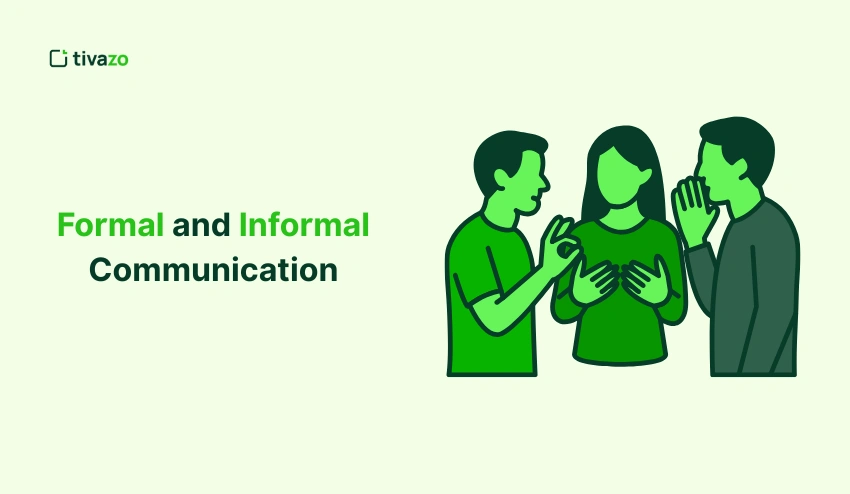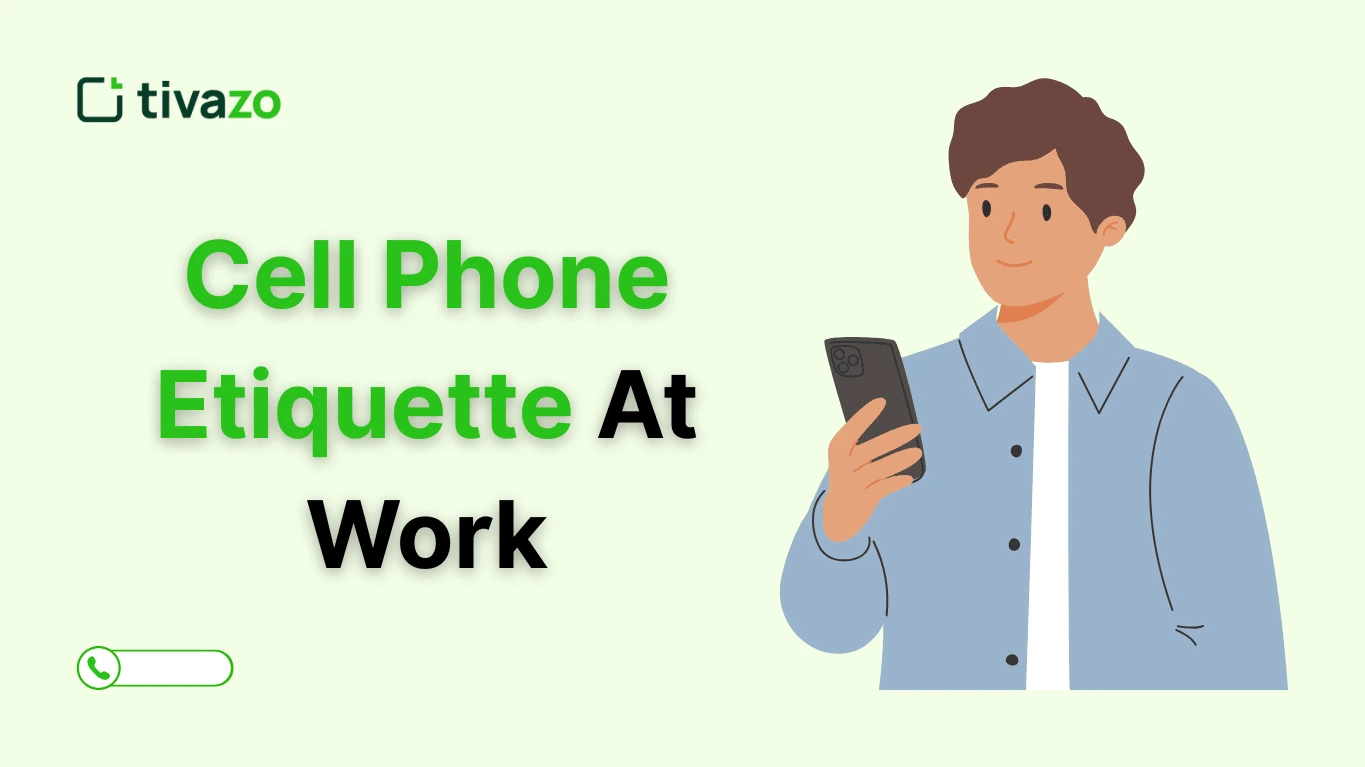Remember the last time you were in a meeting. Did a colleague roll his or her eyes when someone was talking? Did the confident tone of your manager make you consider his point more seriously? These small things occur every day and you can tell a lot without uttering a single word.
That is the strength of nonverbal communication in workplace. Not only what you say, but how you say it. Whether it be through facial expression and body language, or through the tone of voice and personal space, these cues can either reinforce what you are saying or turn it on its head.
In this guide, we will deconstruct what nonverbal communication at workplace actually is, why it is important, and how you can use it to win trust, build better work relationships, and even solve conflicts. You will also get to know what can go wrong when these cues are used and how to prevent the most common ones.
We can begin with a simple definition of what we are talking about.
What Is Nonverbal Communication at Workplace?
In simple words, nonverbal communication in the workplace is the communication that we convey without the use of speech. The body language, facial expression, eye contact, hand gestures, and even tone of voice are what make people interpret us in a certain way. These signals are in most instances, louder than our choice of words.
As an example, a team leader may say, I believe in this project. However, when their posture looks bent and the tone of their voice is flat, workers might question their belief. On the other hand, confident body language and correct facial expressions can support the same message and give confidence to others.
Nonverbal communication is a major aspect of everyday communication in the workplace. They assist employees to develop trust, managers express confidence, and teams work together. Nonverbal behaviors may make a job interview or a virtual meeting feel either clear, respectful, and professional or confusing and dismissive.
Now that you understand what nonverbal communication at workplace actually is, it is time to understand why it has a lot of weight in the workplace.
Why Nonverbal Communication Matters in the Workplace
Words are important, but the way we say them is frequently even more important. Nonverbal communication at workplace affects how others receive our messages, the perception of us by colleagues, and the ease with which teams operate.
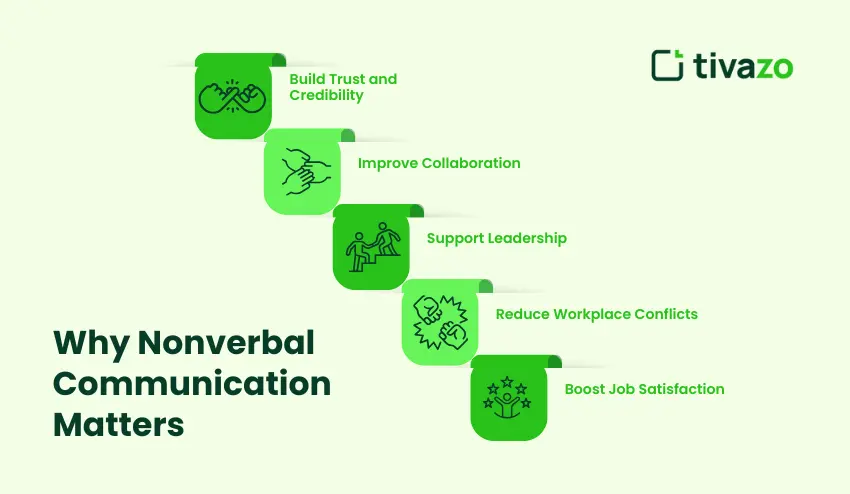
The following are some of the reasons why it is so important:
1. Build Trust and Credibility
Mismatches between words spoken and actions performed are easily detected by the employees. Trust can be lost when a manager offers to support but refuses to maintain eye contact or uses closed body language. There are clear and consistent nonverbal behaviors that can be used to build trust and strengthen workplace relationships.
2. Improve Collaboration
Team projects do not depend on verbal communications only. Openness and respect are expressed by positive body language, hand gestures, and a faint smile during conversations. These signals help colleagues feel special, which has a direct positive effect on collaboration.
3. Support Leadership
Leaders apply nonverbal communication skills in their daily lives, be it in keeping personal distance during a conversation, effective body posture in a presentation, or the tone of voice during a meeting. Such minor cues can make managers appear confident and motivate their subordinates.
4. Reduce Workplace Conflicts
Misinterpretations usually begin when verbal messages are in conflict with nonverbal messages. Through good nonverbal communication, practitioners can ensure that small problems do not escalate into a conflict in the workplace.
5. Boost Job Satisfaction
When employees are made to feel understood, respected, and supported, job satisfaction grows in general. The nonverbal communication, like active listening gestures, proper facial expression, etc. makes people feel listened to and valued.
To put it in a nutshell, nonverbal communication at workplace is not only about dressing up. It has a direct effect on teamwork, productivity, and company culture. Now we can see how it works out with some real cases.
Types of Nonverbal Communication at Workplace
Understanding the different types of nonverbal communication at workplace helps professionals identify areas where they can improve. All types have their own impacts to workplace relationships, the establishment of trust, and the effectiveness of communication in general.
1. Body Language
Body language is the cornerstone of nonverbal communication. It involves posture, gestures, and movements to convey signals of confidence, attention, or disengagement. Open body posture and purposeful gestures express approachability and professionalism. Meanwhile, poor body posture, fidgeting, or arms crossed creates a negative understanding of perception. Effective body language aligns with verbal communication as a means of reinforcement to the message.
2. Facial Expressions
Facial expressions are among the most expressive nonverbal cues. Smiles, slight head nods, and expressions of interest encourage teamwork and collaboration as well as expressing trust. Inappropriately presented facial expressions, such as a frown, downturned lips, or scowls, etc., can create triggering workplace conflict and downward spirals of team morale and cohesion. Professionals who manage facial expressions positively are exhibiting emotional intelligence and build stronger workplace relationships.
3. Eye Contact
Eye contact is an important medium of assurance and sincerity. When having a conversation, giving a presentation or having a virtual meeting, keeping eye contact and looking at the person helps to engage with your colleagues and demonstrates respect. Staring at your phone or avoiding eye contact can communicate doubt or distraction, even if your words are demonstrably clear. Practicing effective eye contact is an important form of nonverbal communication at workplace. It helps to create effective workplace relationships.
4. Tone of Voice
Tone of voice communicates emotions and other intentions that words may not. A calm and even tone can convey that a speaker is confident and in command. Abrupt or inconsistent tone can easily contribute to escalation and/or misinterpretations. Therefore, it is important for professionals to ensure that their tone fits the intended message and is another tool to build legitimacy and decrease misinterpretations or misunderstandings.
5. Personal Space
Respecting personal space enables others to feel comfortable and shows professionalism. Standing too close to another colleague may make them feel pressured, while being too far away may make it seem as though they are disengaged. Space, or proxemics, awareness that others have a personal bubble, is an overlooked ability that can assist you in managing workplace relationships, mitigating unnecessary tension, and making someone feel secure.
6. Hand Gestures
Hand gestures serve to enhance emphasis and help to convey complex concepts and ideas. Good gestures convey enthusiasm and involvement; exaggerated and erratic gestures can confuse or distract your colleagues. Furthermore, small gestures, for example, nodding your head, or making a small hand gesture, allow you to clarify active listening and make a strong impact on nonverbal communication at workplace.
7. Appearance and Professional Attire
Your professional appearance conveys respect, confidence and competence. When you dress appropriately for your workplace, you convey that you take your position and role seriously. Your appearance, along with body language, tone and facial expressions, will support and add to your nonverbal communication.
By learning these types of communication, professionals will elicit confidence in others, communicate more effectively in the workplace, and reduce conflicts in the workplace. Next, we will discuss what may occur when nonverbal communication at workplace is done incorrectly in the workplace and its effects.
Examples of Nonverbal Communication at Workplace
Understanding nonverbal communication at workplace becomes easier when we see it in action. These examples can tell you how minor actions can affect professional relationships, interpersonal relationships, and the entire organizational culture. In all examples, we will also emphasize good behaviors and compare them with bad behaviors to demonstrate how they affect workplace relationships, performance and the work culture.
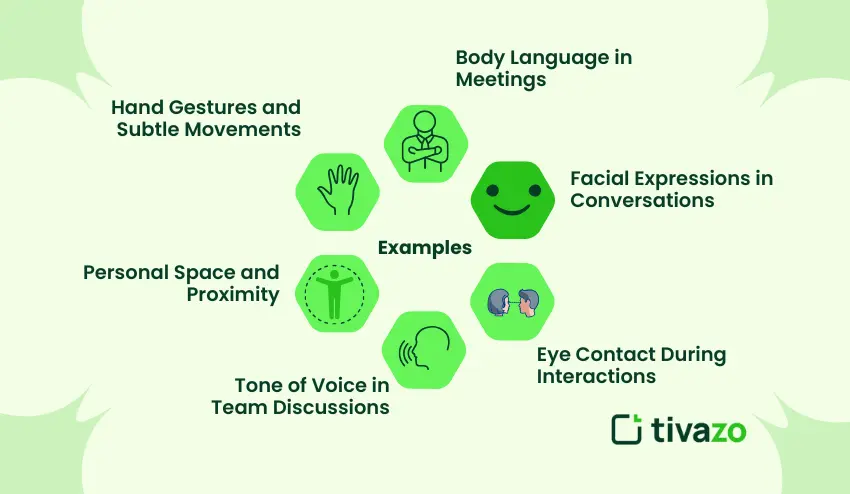
1. Body Language in Meetings
Positive examples: Sitting straight with open shoulders and uncrossed arms are signs of interest and willingness to cooperate. Bending forward a bit will indicate that one is interested and will invite others to be active. There are also controlled hand gestures that are used to emphasize points.
Negative examples: Slouching, crossed arms or fidgeting can be interpreted as disinterest or defensiveness. Sitting too straight or not moving can create the impression that you are not approachable or inattentive to your colleagues.
2. Facial Expressions in Conversations
Positive examples: When you smile at the right time when meeting colleagues or during a conversation, it makes the atmosphere more friendly. Nodding during feedback indicates a sense of listening and reassurance, which helps to build trust.
Negative examples: In the process of feedback, if you frown, scowl, or use the wrong facial expression, it may cause tension, misunderstanding, or demotivation of the team. The expressions that don’t match the verbal messages may cause people to doubt your words.
3. Eye Contact During Interactions
Positive examples: When talking in a one-on-one situation or making a presentation, maintaining eye contact with your listener or audience sends a message of confidence, sincerity, and involvement. During virtual meetings, when you look at the camera, it feels like you are making eye contact, which makes communication more effective.
Negative examples: Not making eye contact can be taken to mean that you are not sure or interested in what you are saying. Excessive or extended staring may also cause discomfort to other people.
4. Tone of Voice in Team Discussions
Positive examples: A smooth, low-pitched voice will give the impression of confidence and professionalism. Changing tone according to the situation, whether giving instructions, praise, conflict solving, etc, reinforces your message and will help minimize misunderstandings.
Negative examples: A fast, high-pitched, or monotone voice may cause unwarranted conflict in the workplace, or it may make your message seem unconvincing. A tone that is not uniform can confuse the audience and make the speaker seem less believable.
5. Personal Space and Proximity
Positive examples: Giving others their space in the interaction is a sign of professionalism and creates a comfortable atmosphere of interaction. In conversation, spacing shows that you are paying attention and that you have a good relationship in the workplace.
Negative examples: Too short of a distance may be part of that person’s belief in personal space which can be disrespectful or may come across as aggressive and on the other extreme, too much distance can signal you have not interest or you are distracted and disrupt communication and development from the group as a cohesive team.
6. Hand Gestures and Subtle Movements
Positive examples: Hand gestures have value when the intent conveys a concept, gives emphasis to certain points, or helps secure the audience members’ attention. Smaller things, like nodding and leaning way slightly forward are cues of active listening and help signal trust to the speaker.
Negative examples: Excessive hand signals distract co-workers from their work and can detract from your credibility. If you tap your hands or fidget too much, it denotes impatience or anxiety.
The examples show that nonverbal communication at workplace extends past gesture, when facilitated positively, body language in the right context, facial expressions in the right situations, eye contact from the right participants, tone during the right interactions and personal space did have a stake in facilitating communication.
Consequences of Improper Nonverbal Communication
When workers poorly use nonverbal communication at workplace it can have serious impacts. This can be seen in professional relationships, team dynamics, and overall productivity. Nonverbal communication is likely to cause confusion and disagreement when it is in conflict with verbal communication.
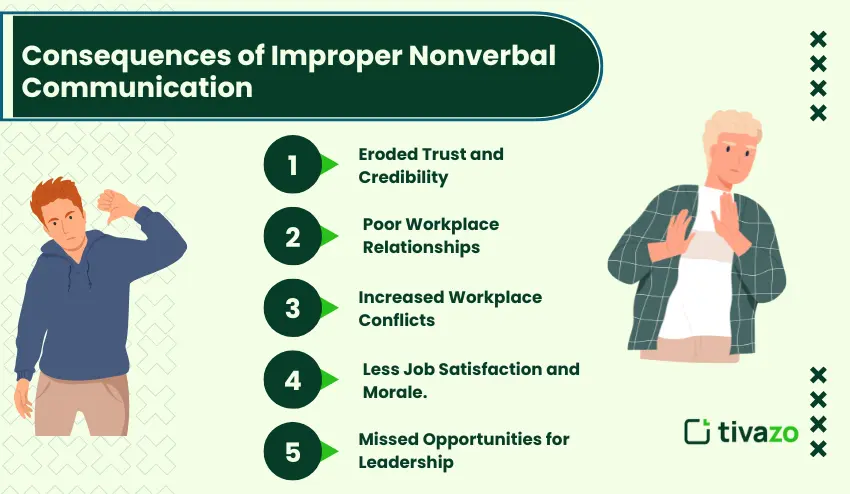
1. Eroded Trust and Credibility
Positive approach: Using consistent body language, facial expressions, and tone builds trust over time.
Negative effects: Ambivalent cues, such as telling someone you are open to feedback and then avoiding eye contact or fiddling, may harm credibility and cause your colleagues to doubt your honesty.
2. Poor Workplace Relationships
Positive style: Respecting personal space, appropriate facial expression and showing attentive listening reinforces relationships in the workplace.
Adverse effects: When people ignore these signals or use closed body language, others will feel undervalued or disconnected, which leads to friction in teams.
3. Increased Workplace Conflicts
Positive style: Gestures are controlled, tones are calm, and active listening lessens misunderstanding.
Adverse effects: Violent behavior of hands, rough voice or even improper facial expressions can turn a small problem into a serious conflict at the workplace. Proper nonverbal communication at workplace is a significant factor as it prevents conflicts.
4. Less Job Satisfaction and Morale.
Positive style: When there is positive body language, slight smiles, and gestures, colleagues feel respected and appreciated. This will inspire confidence and may improve morale.
Negative consequences: Nonverbal negative behaviors such as avoiding eye contact, being bored, fidgeting, and others can demoralize the team, decrease job satisfaction, and impede cooperation.
5. Missed Opportunities for Leadership
Positive style: Leaders who master nonverbal communication are able to lead with confidence and inspire confidence among the workforce.
Negative consequences: Ineffective nonverbal communication will never work (slouching, irregular movements, eye contact, etc.) and may diminish the effectiveness and influence of leadership.
Simply put, improperly executed nonverbal communication at workplace may destroy relationships, trust, and productivity in the workplace. Any good communication in any work setting demands that a person listen to the body language, facial expression, tone of voice, and personal space.
How to Improve Nonverbal Communication at Workplace
To improve nonverbal communication at workplace we have to build on our awareness, practice, and consistency. Even a small difference can make a great difference in how colleagues and work in a team are perceived. An extremely simple, bare-bones guide to instructions is as follows:
- Practice Active Listening
- Look in the eyes and nod now and then to show interest.
- Use nonverbal expressions, which are relevant to the conversation.
- You should avoid looking at your phone or look away.
- Maintain Open Body Language
- Keep shoulders loose, the arms must not be crossed and the posture must be straight.
- When listening or talking, it is better to lean forward to express an interest.
- Keep yourself straight and still, this is a sign of boredom.
- Align Tone of Voice with Message
- Speak in a steady voice and sound confident.
- Vary voice to show that something is important or to show pity.
- Avoid abrupt, high-pitched, or monotone speech.
- Respect Personal Space
- Maintain appropriate distance during conversations and respect others’ workplace boundaries.
- Be mindful of colleagues’ comfort and cultural differences.
- Being too near or too far is both an indication of being intrusive or not being interested.
- Use Facial Expressions Effectively
- Nod to make people talk, and smile.
- Match facial expressions with verbal messages for clarity.
- Do not sulk, scowl or seem to be bored.
- Be Mindful of Gestures
- Point in a disciplined manner.
- Nodding and small movements are signs of active listening.
- Make too few or too many distracting or credibility-killing gestures.
- Practice in Virtual Meetings
- The simulation of eye contact can be made by looking at the camera.
- Nod and smile as a sign of interest.
- Be sure to keep a steady tone. Do not divide and conquer.
The strategies listed below will help in continuously enhancing nonverbal communication at workplace, fostering trust, demonstrating confidence, reducing conflict in the workplace, and enhancing workplace relationships.
Conclusion
Nonverbal communication at workplace controls how messages are received and interpreted. Facial expressions, body language, eye contact, voice tone, and personal space all contribute to trust, collaboration, and productivity.
Proficiency in these cues allows professionals to acquire credibility, improve workplace relationships, reduce conflict, and improve overall job satisfaction. Small, conscious adjustments can lead to a healthy and productive work environment.

